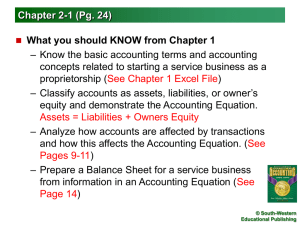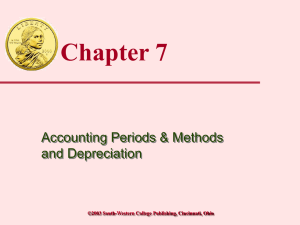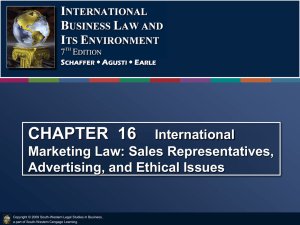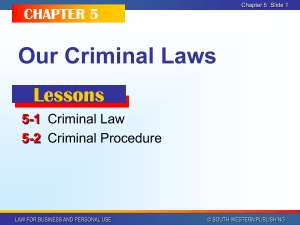ch09
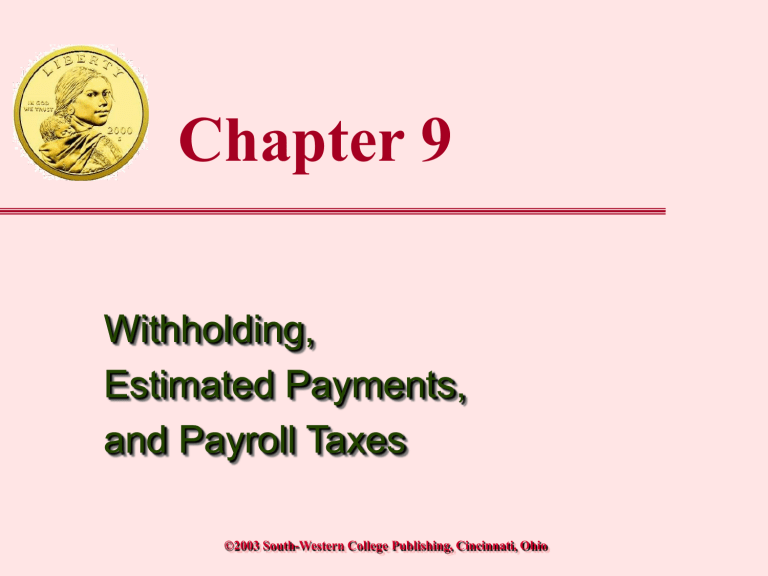
Chapter 9
Withholding,
Estimated Payments, and Payroll Taxes
©2003 South-Western College Publishing, Cincinnati, Ohio
Objective
Be able to complete Form W-4: Employee’s
Withholding Allowance Certificate
© 2003 South-Western College Publishing Transparency 9-2
Withholding Methods
Employer must withhold taxes from employees’ pay based on their Form W-4
Pay includes salaries, bonuses, commissions, vacation, some non-cash fringe benefits
W-4 tells employer number of exemptions claimed by employee
single, married, or married but tax withheld at higher single rate
can claim exempt status if had no liability last year and expect none this year
Best tax planning scenario is if withholding equals tax liability (no refund/tax due)
© 2003 South-Western College Publishing Transparency 9-3
Objective
Know how to calculate income tax
(FIT) and FICA tax withholding from wages
© 2003 South-Western College Publishing Transparency 9-4
Computing Withholding
To compute amount to withhold from pay
Employers must know
# of allowances claimed
gross wages for the pay period
marital status
Use IRS tables to calculate federal income tax based on gross wages
© 2003 South-Western College Publishing Transparency 9-5
Withholding on Tips
Employer must receive a tip report from each employee and withholds taxes based on this report
If employee reports less than 8% of gross food/beverage sales in tips
Employer must “allocate” tips up to 8% and collect taxes on these tips
Employer must report to IRS “Annual Information
Return of Tip Income & Allocated Tips” (Form
8027)
© 2003 South-Western College Publishing Transparency 9-6
Other Withholdings
Required withholding on IRA and pension distributions, bonuses, etc.
Backup withholding required on interest and dividends when:
Taxpayer does not provide an identification number (SSN) or provides incorrect number
Taxpayer fails to certify that he/she is not subject to withholding
Backup withholding is 30% of amount paid to taxpayer
© 2003 South-Western College Publishing Transparency 9-7
Estimated Payments
Self-employed taxpayers and other taxpayers with non-wage income must make quarterly estimated tax payments if annual payment due for the year is ≥ $1000 (after withholding)
Quarterly payments due April 15, June 15,
September 15, and January 15 of the following year
Annual required payment is the lesser of
90% of current year tax, or
100% of prior year tax, but
exception if AGI > $150,000 for prior year, then annual required payment = 112% of prior year
© 2003 South-Western College Publishing Transparency 9-8
FICA Tax
Federal Insurance Contributions Act (FICA) was intended to provide retirement benefits for workers and their families
FICA is two taxes
Social Security - 6.2% of first $84,900 of gross earnings
Medicare - 1.45% on total gross earnings
If taxpayer has more than one source of income, possible to overpay Social Security
Taxpayer can then claim the excess with other pre-payments of income tax
© 2003 South-Western College Publishing Transparency 9-9
Federal Tax Deposit System
Employers withhold both FIT and FICA from paychecks and must make deposits either monthly or semi-weekly based upon the total amounts withheld
Monthly - made by 15th of following month
Semi-weekly - made within 3-4 days of running payroll
exceptions:
owe > $100,000 then must deposit within 24 hours
owe less than $1,000 in a quarter, may pay with quarterly
Form 941 Payroll Tax Return
© 2003 South-Western College Publishing Transparency 9-10
Federal Tax Deposit System
(continued)
To make deposit, fill out Form 8109 as a deposit slip and take deposit to a Federal
Depository
If mailed, must be postmarked second day before due date,or
May be electronically deposited via EFTPS
(Electronic Federal Tax Payment System)
© 2003 South-Western College Publishing Transparency 9-11
Objective
Be able to complete Form W-2 and
Form 941 and understand certain other employer payroll reporting requirements
© 2003 South-Western College Publishing Transparency 9-12
Employer Reporting Requirements
Annually, employers must send W-2s
By 1/31 to each employee
By 2/28 with a Form W-3 (transmittal) to the Social
Security Administration
May have obligation to send W-2 and state specific transmittal form to state Department of
Revenue
W-2 shows gross wages, income and FICA tax withholdings and “special Items”
Unreported tips, 401(k) contributions, employer provided day care, and other taxable fringe benefits
© 2003 South-Western College Publishing Transparency 9-13
Reporting Requirements
Annually, employers must complete Form
1099-MISC for each independent contractor
By 1/31 to each unincorporated independent contractor who earned > $600 and provided a service (for example - attorney, lawn service, etc.)
By 2/28 with a Form 1096 (transmittal) to the IRS
May have obligation to send 1099s and state specific transmittal form to state Department of
Revenue
© 2003 South-Western College Publishing Transparency 9-14
FUTA Tax
Federal Unemployment Tax Act requires employers to pay tax to support unemployment payments
Employer pays 6.2% (net) up to first $7,000 per employee per year, but credit of up to
5.4% for state employment taxes
Deposit quarterly (if over $100)
File annual report (940-EZ) to show gross wages,
FUTA wages and FUTA tax
© 2003 South-Western College Publishing Transparency 9-15
Objective
Know how to calculate taxes for self-employed taxpayers
© 2003 South-Western College Publishing Transparency 9-16
Self-Employment Tax (Schedule SE)
Self-Employment (SE) tax is the same as FICA, except taxpayer is both employer and employee.
Therefore, rates are:
Social Security - 12.4% of first $84,900 of net selfemployment income
Medicare - 2.9% on total net self-employment income
If taxpayer has both W-2 wages and self-employment income, the $84,900 limit applies to the combined earnings
Don’t have to pay SE tax if SE income is less than
$400
May take a “for” deduction for one-half of SE tax paid
© 2003 South-Western College Publishing Transparency 9-17
Objective
Understand the special tax and reporting requirements for household employees
© 2003 South-Western College Publishing Transparency 9-18
The Nanny Tax
Household employee is anyone working in taxpayer’s home (full- or part-time) such as cook, housekeeper, etc.
Employer must
Pay FICA on any household employee who earns
> $1,300 in a calendar year
Withhold taxes for household employee and pay
FUTA
Report FICA and FIT annually
© 2003 South-Western College Publishing Transparency 9-19
The Nanny Tax (continued)
Employer must also
Complete a Schedule H and attach to 1040, or
If have 941 and 940 filing requirements for other business, can add household employees on to these reports
Must file W-2 for each household employee who earns $1,300 or more a year
Not required for anyone under 18 unless providing household services is his or her principal occupation
© 2003 South-Western College Publishing Transparency 9-20
The End
© 2003 South-Western College Publishing Transparency 9-21
